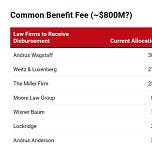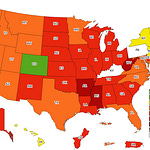Some melanderings here—legal ones and a few others.
Quick update from the legal front: last week, there was one notable development in the glyphosate multidistrict litigation.
Monsanto has been granted permission to formally seek reconsideration of several earlier pretrial rulings. Specifically, this centers on their effort to exclude key plaintiff experts from testifying on scientific and medical matters—topics like causation, toxicology, epidemiology, and oncology, all tied to glyphosate exposure and non-Hodgkin lymphoma.
The court will treat Monsanto’s previously filed brief as its official motion—so no need for them to refile. What this means is Monsanto is getting a second shot at challenging the admissibility of the plaintiffs' expert witnesses.
Previously, the court denied Rule 702 motions—those are legal challenges to the scientific validity of expert testimony. But now, the court is willing to revisit those rulings, likely in light of new information or a reframed legal argument.
Plaintiffs are expected to respond this week. After that, the court will decide whether to uphold its original decisions or revise them.
Why does this matter? Because expert testimony is the foundation of the plaintiffs' case. If Monsanto succeeds in excluding these voices, it could impact upcoming trials. I’ll provide links to the original motions below:
326 Solomon Hamburg 31Mar25
324 Kevin Knopf 31Mar25
319 Kristan Aronson 25Mar25
317 Mark Levin 20Mar25
313 Martyn Smith 13Mar25
As you can imagine, as checking today, Monday the 14th, some plaintiff law firms are very pleased with the recent Barnes v. Monsanto outcome, and that win will likely give them more momentum to keep pushing forward. According to a post from the Lawsuit Information Center on April 8th, the next Roundup and glyphosate-related trials are set to pick back up in May in St. Louis. There’s also another multi-plaintiff case scheduled for June in Chicago (LINK).
Interestingly, there hasn’t been much noise lately about the internal battles over common benefit fees and how those funds are being divided among firms—but that doesn’t necessarily mean those issues are resolved. Some of this might just be happening behind closed doors for now, this may be important for other litigation.
Regarding Other Ongoing Litigation
For some perspective, while the RoundUp/glyphosate litigation often dominates the headlines, there are several other multidistrict litigations (MDLs) quietly unfolding that deserve attention. Among them, the Johnson & Johnson cases remain especially daunting in scale, even when compared to the others. That said, the landscape has shifted significantly due to recent settlements in various cases (e.g., 3M combat ear plugs). For an up-to-date view, see the U.S. Courts website offers a comprehensive listing. It’s also worth noting that litigation involving certain vaccines, therapeutics, and other plant protection products are still very much active.
Baby Food, Heavy Metals, Girl Scouts, and Space Travel?
In my last post, I talked about the future of food—specifically, how precision fermentation could reshape our view of “highly processed” foods. That thread has really stuck with me, and it actually started with something shared by the folks at WePlanet.
What’s wild is how this one topic touches so many others: genetic engineering, the baby food heavy metals litigation, the recent Girl Scout cookie controversy—and even the science of feeding humans in space. It's all more connected than you’d think. You’ll probably hear more from me on that soon.
And quick side rant: where are all the space medicine docs and physiology experts when it comes to Mars colonization? It’s baffling how little we hear about real human limits—like bone loss and the failure of exercise to fully counteract it—when the multiplanetary crowd starts dreaming big. But that's a rant for another day.
Back to fermentation: yes, it’s highly processed by design. And I get it—“highly processed” has become a dirty phrase, mostly thanks to fearmongering. But these foods are made in sterile, tightly controlled environments. That means they could actually be safer—even engineered to be more nutritious—than conventional or organic options.
Because when you grow food in soil—especially at scale—contaminants like heavy metals come with the territory. Arsenic, lead, cadmium, mercury… they’re naturally occurring, and more common than most people realize.
Which brings me to the baby food lawsuits. Keep your eye on this. Officially called MDL-3101, it's a major consolidated case led by Wisner Baum, with over a hundred families involved. The targets? Gerber, Beech-Nut, Walmart’s Parent’s Choice, Earth’s Best, HappyBaby, Plum Organics, and Sprout.
The allegation? That these companies sold baby food contaminated with toxic metals—exposures that, according to the lawsuits, may have contributed to conditions like autism, ADHD, and other neurological challenges.
It’s a heavy topic, but it brings us back to a big question: how do we feed ourselves—and especially our most vulnerable—in a world where “natural” doesn’t always mean “safe”?
FDA Analytical
For a bit of context on heavy metals—especially in baby food—it’s worth taking a look at the FDA’s most recent assessments. They’re a good reminder that “natural” doesn’t always mean safe.
Heavy metals are natural. Arsenic, lead, mercury… they’re part of the earth. But just because they’re natural doesn’t mean they’re harmless. One thing that’s almost always missing from influencer takes on this subject is a key public health principle: we aim to keep heavy metal exposures As Low As Reasonably Achievable—or ALARA. It’s not about zero, it’s about minimizing risk while staying grounded in reality.
And here's the ironic part: some of the very same people panicking about trace metals in baby food are also raving about “mineral-rich” gourmet salts—many of which contain, you guessed it, heavy metals.
If you're curious, I’ve linked to the FDA’s testing results—definitely worth a look if you want to see how the data actually plays out.
FDA Testing results for Arsenic, Lead, Cadmium, and Mercury 👈 (have a look 👀)
And speaking of what’s actually in our food—natural or otherwise—did anyone else catch what I think was a carrageenan mention in one of the newer Black Mirror episodes? Pretty sure I didn’t imagine that.
Carrageenan—pronounced ker-ə-ˈgē-nən—is one of those ingredients that tends to show up on labels, spark questions, or demonstrate ignorance.1 It's used in very low levels as an emulsifier, stabilizer, and thickener. It’s a colloid, extracted from certain types of red algae—like Irish moss—and various seaweeds.2
And yes, like many natural ingredients, those sources can contain trace amounts of heavy metals: arsenic, lead, cadmium. Again, just because it comes from nature doesn’t automatically give it a clean bill of health. This is why ongoing testing and regulatory oversight matters so much.
If you’re curious, I’ve linked the FDA’s analysis on this too—it’s worth a skim. Might help recalibrate some assumptions.
Oh—and I’ve got a draft coming up on the Girl Scout cookie litigation. That one’s layered in more ways than you might expect, so stay tuned. And of course, stay safe out there…
If I don’t know that food additive, can’t pronouce it, or it has a chemical sounding name, it must by dangerous! ? -Reminder: RFK Jr. 😱 - riboflavin | ri·bo·fla·vin | rī-bə-ˌflā- | /ˌraɪ.bə.ˈfleɪ.vɪn/ !!!!). - aka - vitamin B2, a water-soluble vitamin that helps with energy production, cellular function, and growth. It's found in many foods, including dairy, meat, and leafy greens
The Black Mirror Season 7 episode that references carrageenan is "Bête Noire". In this episode, Maria proudly developed a new mallow-based candy using carrageenan, a seaweed-based gelatin, to cater to Mr. Ditta's Hindu dietary restrictions. However, the plot twist reveals that the mallow actually contains beef gelatin, not carrageenan.














Share this post